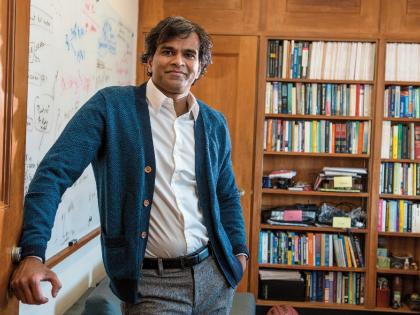Mutation is the engine of evolution: organisms would not be able to evolve new characteristics if their DNA did not randomly acquire small changes. But mutations can also be dangerous. If too many life-threatening mutations appear too quickly, an entire species could face extinction. Now a group of Harvard scientists has calculated the number of mutations that can appear in any organism’s genome in each generation without threatening a population’s survival. And because this “speed limit” on genetic change arises from fundamental properties of molecules, the limit is the same for the simplest viruses and the most complex plants and animals.
The study, which appeared recently in Proceedings of the National Academy of Sciences, links two lines of scientific research: the detailed investigation of the physical properties of proteins, and the broader study of evolutionary change. DNA serves as a template for building proteins, which are the primary actors in the cells of organisms. Professor of chemistry and chemical biology Eugene Shakhnovich, the study’s lead author, says that a great deal is known about the three-dimensional properties of proteins and how their shape affects their function. “The next step,” he explains, “is to understand how the proteins’ shape affects the behavior of organisms,” including their survival and evolution.
His team, led by research associate Konstantin Zeldovich, focused on a key property of proteins: their stability. Some mutations in DNA affect the way proteins fold into three-dimensional structures. Critical proteins must be structurally stable for an individual organism to survive; on a population level, if too many individuals die out because their proteins are unstable, a species risks extinction.
To find the limit on mutations per genome per generation, the team modeled a range of possible stabilities for proteins essential to life. Employing a diffusion equation, widely used in physics, they calculated the balance point at which too many proteins become unstable for a population to survive. The answer they came up with: six mutations per generation.
Shakhnovich notes that this absolute speed limit illustrates why organisms that have very large genomes, such as mammals, must mutate very slowly: it is far more difficult to ensure that fewer than six mutations occur in a genome with billions of potential mutation sites than in one with several thousand. In fact, he says, most organisms operate far below the theoretical speed limit because they have developed elaborate error-correction systems to ensure that mutations occur only rarely.
Some diseases, on the other hand, thrive by operating near the fundamental limit of mutation. Viruses, and particularly RNA viruses like HIV, have relatively high mutation rates; only by changing their proteins constantly can they evade their host’s immune system. Certain bacteria speed their evolution by shutting down their error-correction systems. Cancer cells grow and spread by mutating more quickly than normal cells.
The six-mutation rule has real-world applications. Certain therapies already take advantage of such limits by drastically boosting mutation rates in order to kill their targets: radiation therapy to treat cancer, for example. At the same time, the low mutation rate that allows complex organisms to support large, stable genomes limits their ability to adapt quickly in response to new conditions, as a virus or bacterium would. Global warming, for instance, may pose a particular threat to those species that evolve slowly—and Shakhnovich’s team is trying to understand in more detail how the need to maintain a stable genome affects the speed at which organisms can adapt to environmental change.
~Courtney Humphries








